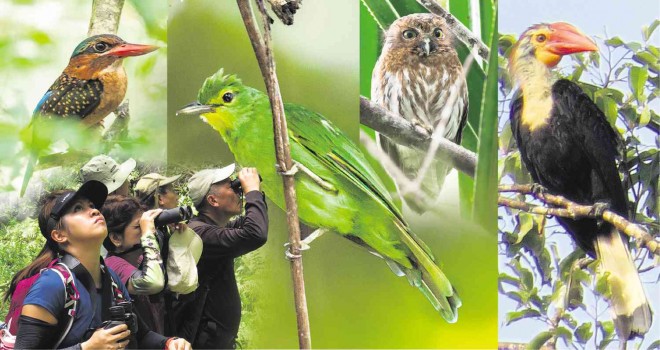Paradise lost for very rare PH birds
BISLIG, Surigao del Sur—Patches of tropical rainforest in Mindanao harbor some of the world’s rarest birds, but nature lovers toting long-lens cameras now share them with people wielding chainsaws, traps and torches.
Hundreds of foreign and local tourists venture each year into the remote region, which is also known as a sanctuary for communist rebels, but hardly any of the trees are left and bird sightings are on the decline.
“Back in the 1990s, I’d take them to one area and they would see all the endemics in one day,” local guide Felizardo Goring said, referring to species found only in the Philippines.
“Now, there’s no guarantee you’ll find them even if you went looking everywhere for three days,” he told Agence France-Presse (AFP) after a failed predawn sortie for the giant scops owl, a mysterious bird found only in the country’s south.
The 183,000-hectare forest is a vital habitat for dozens of endangered bird species, including the electric-blue celestial monarch, according to British-based environment group Birdlife International.
Article continues after this advertisementBut the bird habitat’s demise started in the early 1950s when the government awarded a contract to a local logging firm, which cleared massive amounts of the forest, according to Goring, who used to work for the company.
Article continues after this advertisementThe license, which included growing trees on cleared land for pulp and paper production, was withdrawn in 2002. What may have appeared as a victory for the bird lovers quickly turned sour as settlers from all over the country descended on the area, hacking and burning their way in to create new farms, Goring said.
Goring, 59, used to work for the pulp and paper mill as one of more than 200 guards securing the sprawling concession.
He said there were no other jobs available in the impoverished region and his father also worked for the timber firm.
Goring finally quit in 1994 to become a birding guide as the area became particularly popular with European birders.
Burning down paradise
His life since then has been filled with beauty, with the forest’s remaining birdlife still remarkable, although it has retreated into the chunks of forests yet to be cut down by the growing number of settlers.
On a recent tour for five Filipino tourists, which AFP took part in, Goring coaxed one of the forest’s signature birds, a writhed hornbill with a large, deep-red casque, by copying its honk expertly with a hand cupped around his mouth.
Noses, cameras and binoculars cocked, the birders then breathlessly followed the guide’s forefinger toward a male Philippine trogon, possibly the country’s most colorful bird, neighing like a horse behind the bushes.
Walking on a unused logging road and through the residual thickets, the birding party ticked off blue fantails, a rufous-fronted tailor bird, brown tit babblers and leafbirds camouflaged on the green canopy.
But the celestial monarch and two other endangered birds from the region particularly known for their beauty, the Mindanao bleeding-heart pigeon and the Mindanao broadbill, could not be found.
During four days of trekking, the forest echoed with the whir of unseen chainsaws and freshly cut wood planks were piled on the roadside for trucking off.
The team frequently stumbled across patches of freshly burnt forests and grasslands, with new wooden huts establishing yet more settler communities.
Some of the huts were surrounded by sacks full of charcoal, apparently from burnt trees and intended to be sold as fuel for barbecue grills.

BIRD PARADISE GOING, GOING, GONE A 183,000-hectare rainforest in eastern Mindanao, once home to dozens of endangered bird species, has shrunk due to commercial logging and invasion by settlers, who hack and burn their way to create new farms. Only patches of the forest remain that bird watchers now share with people wielding chainsaws, traps and torches. On a recent trip, a group of birders came across blue fantails, a writhed hornbill, a rufous-fronted tailorbird, brown tit-babblers and leafbirds in chunks of forest yet to be cut by settlers. AFP
Disheartening
The scenes were disheartening for pensioner Jude Sanchez, making his second visit in five years to photograph the monarch, a forest standout because of its dazzling plumage and an extravagant, mohawk-style crest.
“The last time I was here, there was no burning yet. Now it’s almost everywhere,” he said.
At one point during the tour, a local man on a motorcycle tried to sell the visitors a trapped parrot, giving the downcast birders a first-hand confrontation with another method of killing off a species.
Goring explained the blue-naped parrot disappeared locally about 15 years ago, primarily because of the pet trade.
He said forest birds sold for as little as P500 in the markets of Bislig, the nearest city about two hours’ drive away, with customers buying them for food as well as pets.
Asia-wide devastation
The destruction at Bislig is typical of what is happening to tropical rainforests and wetlands across Asia.
Birdlife International said in its latest State of the World’s Birds report that Asian forests suffered from “unsustainable forestry practices, with 0.7 percent of the remaining natural forest lost to logging each year.”
“This degree of habitat loss, degradation and fragmentation has serious consequences for birds,” the report said.
Four Asian nations—the Philippines, Indonesia, China and India—are among 10 countries with the highest numbers of globally threatened birds, it said.
In Bislig, Goring believes all the birds will soon disappear as the last of their habitat is stripped away to accommodate the new human arrivals, which currently are estimated in the thousands.
The area is not an officially protected park, despite its importance to birds.
While a national logging ban has been in place, authorities typically cannot enforce it in remote places, such as Bislig, because of insufficient funding and manpower.
“In 10 years all these areas will be bald,” Goring said. “We’re still seeing birds now but they will all vanish with the remaining forests.” AFP